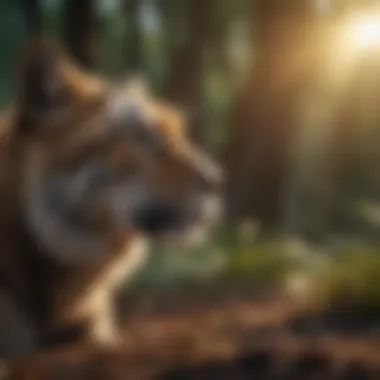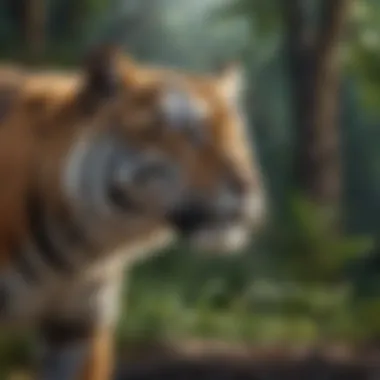Understanding Threatened Species: Challenges & Implications


Overview of the Topic
Biodiversity is a foundation of ecological health. However, many species around the world are facing a risk of extinction. The classification of these threatened species serves as a critical alarm for humanity to understand the consequences of declining biodiversity. The list of threatened species is not just a inventory of animals and plants under threat; it reflects broader environmental issues influenced by human activity, climate change, and habitat loss. This article aims to examine the factors that lead to the classification of species as threatened, explore the implications of biodiversity loss, and evaluate current strategies for conservation.
To understand the relevance of this topic, one must consider the essential services biodiversity provides. These services include pollination, clean water supply, and carbon sequestration. The decline of species disrupts these functions, which can lead to significant ecological imbalances. Thus, it becomes imperative to scrutinize the processes involved in creating the list of threatened species and the challenges associated with conserving these vital components of our ecosystems.
Current Status and Challenges
The current status of threatened species is alarming. According to the International Union for Conservation of Nature (IUCN), over 28,000 species are currently listed as threatened. This encompasses various categories, from critically endangered to vulnerable. Factors that have led to these classifications include habitat destruction, pollution, invasive species, and climate change, all of which are exacerbating the decline in population sizes.
Major Challenges
- Habitat Loss: Urban expansion, deforestation, and agricultural practices are contributing to a rapid decline in natural habitats.
- Climate Change: Altered weather patterns disrupt migration, breeding, and food availability for many species.
- Pollution: Chemicals and waste in water bodies degrade ecosystems, harming both terrestrial and aquatic life.
- Invasive Species: Non-native species can outcompete local flora and fauna, leading to population decreases of native species.
Addressing these challenges requires a multifaceted approach, as these threats often interrelate. Agencies involved in wildlife conservation face obstacles such as limited funding, lack of public awareness, and varying regulations across regions.
"Conservation of threatened species is about more than saving animals; it's about safeguarding our planet's health."
Sustainable Solutions
To combat the challenges facing threatened species, sustainable practices must be implemented. This involves an amalgamation of strategies tailored to the specific needs of different species and ecosystems.
Effective Conservation Strategies
- Protected Areas: Establishing wildlife reserves and parks to shield habitats from human encroachment.
- Restoration Projects: Healing damaged ecosystems through reforestation and cleaning polluted environments.
- Legislation and Advocacy: Strengthening laws that protect endangered species and their habitats while promoting public engagement in conservation efforts.
Case Studies
One notable example is the recovery of the California condor. Once on the brink of extinction, concerted conservation efforts, including breeding programs and habitat protection, have helped increase its population from just 27 individuals in the 1980s to over 400 today. Such instances exemplify the potential for successful intervention.
Impact and Importance
The impact of declining species extends well beyond individual organisms. Ecosystem health is tied intricately to these species. A loss in biodiversity can affect food webs, leading to unforeseen consequences for entire ecosystems. Communities that rely on these ecosystems for their livelihoods, such as fishing and tourism, face economic repercussions as well. This emphasizes the importance of conservation efforts.
Future Generations
Preserving threatened species is not just about current biodiversity; it is about ensuring that future generations inherit a healthy planet. Emphasizing sustainable resource use and respecting ecological limits must be integral components of planning and policy-making. It is essential for conservationists, students, and environmentally aware individuals to remain informed and active in these discussions to foster a deeper understanding of our role in environmental stewardship.
Prologue to Threatened Species
Understanding the concept of threatened species is crucial for discussing the implications and challenges that come with biodiversity loss. This section serves to lay a foundation for the entire article, emphasizing the immediate necessity of preserving numerous species that face the threat of extinction.
Defining Threatened Species
A threatened species can be described as any species that is at risk of extinction in the near future. The classification of species into various categories is based on criteria set forth by organizations such as the International Union for Conservation of Nature (IUCN). Criteria include population size, rate of decline, and geographic distribution.
Species can be designated as vulnerable, endangered, or critically endangered, each indicating increasing levels of risk. The process of classification helps in prioritizing conservation efforts. It is essential for conservationists, as it directs limited resources to where they are most needed. Understanding these definitions can facilitate better communication about conservation needs among stakeholders.
The Importance of Biodiversity
Biodiversity is a measure of the variety of life on Earth. It encompasses all species of plants, animals, fungi, and microorganisms. This richness of life supports vital ecosystem functions such as pollination, nutrient cycling, and climate regulation.
The loss of biodiversity can have far-reaching effects. It not only threatens individual species, but also disrupts ecosystems and the services they provide to humanity. Ecological health is a fundamental aspect of our quality of life and the economy. Therefore, protecting biodiversity is not merely an environmental issue, but also an economic and social one.
Maintaining biological diversity ensures resilience against disasters, be they natural or man-made. The connection between biodiversity and human health is significant, as many medicinal resources derive from biological sources. Hence, conservation of threatened species plays a critical role in fostering a sustainable future.
"The health of our planet is closely tied to the health of its biodiversity."
In summary, the identification and understanding of threatened species is a first step towards mitigating threats to biodiversity and ensuring the stability of ecosystems, which ultimately supports life as we know it.
Global Trends in Biodiversity Loss
Biodiversity loss is a pressing concern that reflects broader environmental issues. Recognizing global trends can guide conservation efforts and policy decisions. A decrease in biodiversity affects ecosystem functions and resilience, and it is linked to various factors like human activity and climate change. This discussion helps in appreciating the complexities involved in safeguarding our natural heritage. It emphasizes the need for immediate, informed action and strategic planning in conservation initiatives.
Statistical Overview of Threatened Species


The statistics surrounding threatened species are alarming. According to the International Union for Conservation of Nature (IUCN), more than 37,000 species are currently on the Red List of Threatened Species. The number of endangered species seems to be continually increasing as ecosystems degrade. The extinction rate is now alarming, estimated to be 1,000 times the natural background rate. This indicates that we are losing species at a rate that is unsustainable and detrimental to overall biodiversity.
Understanding these numbers is crucial for both conservationists and policymakers to prioritize their efforts and allocate resources efficiently.
Geographical Distribution of Threatened Species
The geographical distribution of threatened species reveals where the most significant conservation efforts are needed.
Regions with the Highest Biodiversity
Areas like the Amazon Rainforest, the Coral Triangle, and Madagascar are known for their rich biodiversity. These regions contain numerous endemic species, which are not found anywhere else on the planet. The Amazon rainforest alone houses one-tenth of all species known to science. Such regions are crucial for maintaining ecological balance and provide numerous ecosystem services including carbon storage and climate regulation. However, these regions are also under immense threat from deforestation, pollution, and habitat fragmentation.
Highlighting these areas and their unique characteristics in this article sheds light on their significance for conservation efforts globally. Protecting these habitats is essential to prevent further biodiversity loss.
Factors Contributing to Variability
Multiple factors contribute to the variability in the number of threatened species across different regions. One critical element is the level of legal protection these areas receive. Regions with strong conservation laws and active community involvement often show better outcomes for species preservation.
Conversely, political instability, economic development pressures, and lack of enforcement of existing laws can lead to rapid declines in biodiversity in certain areas. This article's focus on variability emphasizes the importance of contextual understanding in conservation strategies.
"Preventing biodiversity loss is not just an environmental issue; it is also a matter of ethics, culture, and global equity."
In summary, understanding global trends in biodiversity loss is vital for sustainable conservation practices. The staggering statistics and the geographical analysis illustrate the urgency of addressing both direct and indirect threats to endangered species.
Criteria for Classification as Threatened
The classification of species as threatened is an essential process within the broader context of biodiversity conservation. Understanding these criteria allows for effective intervention and resource allocation towards those species in critical need. This section emphasizes the necessity of classifying species accurately to guide conservation efforts and policy making.
IUCN Red List Categories
The International Union for Conservation of Nature (IUCN) Red List categorizes species based on their risk of extinction. It serves as a key resource for conservationists and policymakers. The categories range from "Least Concern" to "Extinct," providing a clear framework for understanding a species' conservation status.
By having a standardized classification system, conservation efforts can be prioritized effectively, directing resources where they are needed most.
Evaluation of Species Status
Understanding how to evaluate the status of a species is crucial for determining its level of threat. Evaluation generally involves three main criteria: population dynamics, habitat loss, and rate of decline.
Population Dynamics
Population dynamics refers to the changes in population sizes and structures over time. It is a key aspect of evaluating species health.
Monitoring population size helps identify trends that indicate whether a species is declining, stable, or recovering.
A key characteristic of population dynamics is its ability to reveal both short-term fluctuations and long-term trends, making it a beneficial choice for conservationists focusing on species recovery efforts.
Without understanding population dynamics, efforts to protect endangered species may miss critical intervention opportunities.
Habitat Loss
Habitat loss is a primary driver of species endangerment. The destruction of natural habitats due to human activity leads to a direct decrease in available living space for many species. Understanding habitat loss helps conservationists develop strategies to mitigate its effects.
This topic is popular because it offers clear indicators of ecological degradation.
Recognizing the unique features of habitat loss—such as fragmentation and degradation—enables targeted actions to restore or protect vital ecosystems.
Rate of Decline
The rate of decline in species populations is another fundamental component of status evaluation. Understanding how fast a species is disappearing offers urgency to conservation actions. This characteristic makes it a critical measure as it informs the immediacy of required interventions.
Monitoring the rate of decline assists in determining whether current conservation strategies are effective or if they need to be re-evaluated.
If rates are high, it may signal that additional resources and support are necessary to halt or reverse the trend, reinforcing the need for continuous assessment in conservation practices.
The evaluation of species status serves as a foundation for prioritizing conservation initiatives, ensuring that efforts are directed towards the most at-risk species.
Factors Leading to Threatened Status
Understanding the factors leading to the threatened status of species is crucial in appreciating the broader context of biodiversity loss. Each of these elements contributes significantly not only to the decline of individual species but also to the potential collapse of ecosystems. Conservationists, students, and environmentalists must engage with these challenges to formulate strategies that effectively address the underlying issues.
Habitat Destruction
Habitat destruction is often recognized as a primary factor contributing to the threatened status of many species. This encompasses the loss of natural environments due to human activity such as urban development, agriculture, and deforestation. As habitats are degraded or entirely removed, the species that depend on them for survival face dire consequences. The complexity of ecosystems means that loss of a single species can have ripple effects, disrupting food chains and leading to further extinctions. Protected areas, environmental regulations, and sustainable practices can help mitigate this impact by preserving critical habitats and ensuring the survival of diverse species.
Climate Change Effects
Climate change is increasingly recognized as a significant driver of species endangerment. As global temperatures rise and weather patterns shift, many species struggle to adapt to the rapid changes in their environment. This includes alterations in breeding seasons, migration patterns, and food availability. Species unable to adapt quickly may find themselves at risk of extinction. Adaptation strategies, such as habitat restoration and the development of climate-resistant species, are vital in addressing the challenges climate change poses to threatened populations.
Invasive Species Impact


The introduction of invasive species poses another serious threat to native flora and fauna. These invaders often outcompete, prey on, or introduce diseases to indigenous species, which may not have evolved defenses against such threats. For instance, the introduction of the Burmese python in the Florida Everglades has led to the decline of several native species.
Effectively managing invasive species involves rigorous monitoring and control measures, as well as public awareness campaigns. Effective responses can safeguard native ecosystems and help maintain biodiversity.
Pollution and Its Consequences
Pollution, encompassing both land and water, severely affects species health and habitat quality. The introduction of toxins can lead to bioaccumulation in food chains, ultimately affecting not just the species directly exposed, but also predators higher up the chain, including humans. Common pollutants include plastics, heavy metals, and agricultural runoff, which contribute to a decline in water quality and habitat integrity.
To combat pollution, adopting sustainable farming practices, reducing plastic usage, and implementing stricter regulations can play a crucial role in some ecosystems. Education and advocacy are essential to inspire change at both individual and societal levels, fostering a collective responsibility towards environmental health.
"Every aspect of our environment is interconnected; what impacts one species can reverberate throughout the ecosystem."
These factors leading to threatened status deserve careful consideration and action. Addressing habitat destruction, mitigating climate change, controlling invasive species, and reducing pollution are all essential steps in preserving biodiversity. The future of threatened species depends heavily on the actions taken today.
Case Studies of Threatened Species
The exploration of case studies related to threatened species is critical for understanding the broader implications of biodiversity loss. These specific examples provide insight into the complex dynamics of ecosystems and illustrate the consequences of human actions on various species. Case studies help demonstrate the urgent need for conservation efforts and highlight successful strategies being implemented. Through detailed examination of iconic species and endangered flora, we can uncover significant lessons about the interdependencies within ecosystems.
Overview of Iconic Species
Tigers
Tigers hold a prominent place in conservation discussions. Their status as apex predators means they play a pivotal role in maintaining ecological balance. The decline of tiger populations sends a clear signal about the health of their habitat. A notable characteristic of tigers is their solitary nature; this behavior complicates conservation efforts. Because they require expansive territories, protecting tigers can result in a cascading protection of other species within their range. However, they face challenges due to habitat loss and poaching, making them a compelling case study for biodiversity preservation.
Asian Elephants
Asian elephants are another iconic species worth discussing. Their social structure and intelligence have made them essential to their ecosystems. They help shape the environment by being seed dispersers and contributing to habitat management. As a key characteristic, Asian elephants display strong family bonds, relying on communal care. This behavior illustrates the complexity of their social systems. Unfortunately, they are threatened by habitat fragmentation and human-elephant conflicts, making them vital to the conversation about conservation strategies that consider human impacts.
Amur Leopards
The Amur leopard stands out as one of the most endangered big cats in the world. Their elusive nature and difficult habitat make them less understood than other species. A key characteristic of Amur leopards is their adaptability, allowing them to thrive in various habitats when undisturbed. However, their primary threat is habitat loss due to logging and development. This situation raises important discussions around the necessity of creating protected areas and increasing habitat connectivity in conservation plans. Studying the Amur leopard underscores the need to prioritize habitat preservation in conservation efforts.
Regional Studies of Endangered Flora
California's Endangered Plants
California is home to a diverse range of flora, many of which are facing threats to their survival. The state’s unique climate and varied ecosystems growth facilitate a host of rare and endemic species. Studying California's endangered plants serves to highlight the fragility of these ecosystems. A key feature of these plants is their specialization to certain environments, making them particularly vulnerable to climate change and human activity. Understanding these risks allows for targeted conservation efforts aimed at habitat restoration and protection.
Medicinal Plants at Risk
Many medicinal plants are at risk due to overharvesting and habitat loss. Such plants contribute significantly to traditional medicine and modern pharmacology. The specific aspect of medicinal plants at risk is their economic and cultural importance in many communities. They often have unique active compounds that cannot be synthesized. The unique feature of these plants lies in their traditional uses and the loss of biodiversity may limit future medical discoveries. This reality calls for sustainable harvesting practices and habitat protection to ensure their survival.
Conservation Strategies and Efforts
Conservation strategies and efforts are vital components in addressing the threats faced by species at risk. These strategies entail a range of actions designed to protect species, restore habitats, and ensure the sustainability of biodiversity for future generations. Effective conservation efforts can reverse declining populations and create resilient ecosystems. It is essential to understand the various approaches within the conservation framework to appreciate their impact on threatened species.
Protected Areas and Reserves
Protected areas and reserves play a central role in biodiversity conservation. They provide habitats free from the pressures of urban development and industrial activities. By safeguarding natural ecosystems, these areas serve as sanctuaries for many endangered species. The establishment of protected lands also enhances ecological processes, such as nutrient cycling and pollination, which are vital for ecosystem health.
However, establishing protected areas is not without challenges. The criteria used to designate these areas can vary, and conflicts may arise over land use. Local communities sometimes rely on the same resources intended for protection, leading to tensions. Therefore, it is important to manage these areas effectively, balancing conservation with the needs of local populations. Successful protected area management engages stakeholders and includes strategies for sustainable resource use.
Species Recovery Programs
Species recovery programs are specific initiatives aimed at restoring populations of threatened species. These programs often include captive breeding, habitat restoration, and reintroduction of species into their natural habitats. For example, the recovery of the California condor is a notable success. Intensive breeding and release efforts have increased their numbers from a mere 27 individuals in the 1980s to over 500 today.
Each recovery program must tailor its approach based on species-specific requirements. Monitoring population dynamics and habitat conditions is essential to evaluate success. Collaboration among scientists, governments, and local organizations enhances the effectiveness of these programs. As a result, species recovery efforts not only aid in preserving species but also restore the intricate web of relationships within ecosystems.
Community Involvement in Conservation
Community involvement is a cornerstone of effective conservation strategies. Engaging local populations in conservation efforts fosters a sense of ownership and responsibility toward their natural resources. When communities actively participate, they are more likely to adhere to conservation practices. This engagement can take many forms, including education and training, community-led projects, and sustainable livelihood initiatives.
Successful examples illustrate the power of community engagement. For instance, in Namibia, local communities manage wildlife conservancies, leading to increased populations of elephants and other wildlife. This approach not only benefits local ecosystems but also provides economic incentives for the communities involved.


The Role of Legislation in Conservation
Legislation plays a critical role in the conservation of threatened species. It serves as a formal framework for protecting biodiversity, establishing guidelines and protocols that govern human activities impacting the environment. Effective legislation can help mitigate risks and foster recovery efforts for endangered species. This section explores how laws and agreements contribute to conservation initiatives and the ongoing challenges faced.
International Agreements and Protocols
International agreements present a unified approach in addressing the complexities of biodiversity loss. They facilitate cooperation among countries and create a platform for collective action.
CITES
The Convention on International Trade in Endangered Species of Wild Fauna and Flora is commonly known as CITES. Its main objective is to ensure that international trade does not threaten the survival of species. CITES is vital for regulating trade and provides legal protections for over 35,000 species.
A key characteristic of CITES is its tiered approach to species protection. Species are classified into three categories based on their conservation status, ranging from those needing strict protection to those that can be traded under specific conditions. This feature allows for tailored strategies depending on the species' vulnerability.
However, CITES does face challenges. Enforcement varies significantly among member countries, which can limit its effectiveness. Furthermore, the legal trade continues to push some species towards extinction despite the protocol.
Convention on Biological Diversity
The Convention on Biological Diversity, often referred to as CBD, focuses on the conservation of biological diversity and sustainable use of its components. It advocates for fair and equitable sharing of benefits arising from the use of natural resources.
A significant aspect of CBD is its emphasis on the participatory approach. Countries are encouraged to involve local communities in conservation efforts, recognizing their essential role in biodiversity management. This characteristic makes CBD a flexible tool, adaptable to the needs of different regions.
Despite its global reach, CBD also encounters hurdles. The implementation varies widely due to differing national priorities and resource limitations. Additionally, the ambitious targets set under the convention are often not met, reflecting gaps between policy and practice.
National Legislation and Its Effectiveness
National legislation serves as the backbone of local conservation efforts. Each country has the power to enact laws that address specific threats to its biodiversity. These laws should ideally align with international agreements to enhance their effectiveness; however, gaps might exist.
Effective national laws provide strong protections for endangered species and their habitats. They can enforce penalties for illegal poaching and habitat destruction. Yet, enforcement is a major concern. Many countries struggle with limited resources and lack the infrastructure to implement laws properly.
In summary, legislation, both international and national, is crucial in the conservation landscape. It establishes a formal basis to protect threatened species and can help translate conservation goals into actionable strategies. However, challenges remain in implementation and enforcement, emphasizing the need for continuous improvement in legal frameworks.
"The success of conservation efforts hinges not only on the strength of laws but also on their implementation and the commitment of all stakeholders involved."
Future Outlook for Threatened Species
As we consider the Future Outlook for Threatened Species, it becomes clear that understanding this topic is crucial for developing effective conservation strategies. The challenges faced by these species are intertwined with broader environmental issues, compelling conservationists, students, and environmentalists to adopt more informed approaches. This section examines both the obstacles on the horizon and the innovative methods being employed to address them.
Challenges Ahead
Several significant challenges loom over the conservation of threatened species. These challenges are not just limited to species-specific concerns but connect to extensive ecological and socio-economic systems. Some of the critical challenges include:
- Habitat Loss: Continues to be the most pressing concern. Urbanization, agriculture, and deforestation relentlessly encroach upon natural habitats, leading to fragmentation and decline of biodiversity.
- Climate Change: Alters ecosystems and threatens the very survival of many species. Changes in temperature and precipitation patterns affect food availability and breeding cycles.
- Pollution: Encompasses various forms, including air, water, and soil contamination, harming species directly through toxicity.
- Invasive Species: Introduced species can outcompete, prey on, or bring diseases to native populations, exacerbating the stress on already vulnerable species.
These challenges are compounded by insufficient funding and political instability in many regions, making it increasingly difficult to undertake effective conservation measures. Addressing these issues requires a multi-faceted approach and robust international cooperation.
Innovative Approaches to Conservation
In light of these daunting challenges, innovative approaches to conservation have emerged. These strategies aim to create sustainable frameworks for protecting threatened species and their habitats. Here are several noteworthy methods:
- Community-Based Conservation: Engaging local populations in conservation efforts fosters stewardship of natural resources. Providing education and incentive programs allows communities to thrive economically while protecting their environment.
- Habitat Restoration Projects: Efforts to restore damaged ecosystems can have profound impacts on the resilience of threatened species. This includes reforestation, wetland restoration, and more complex landscape-scale conservation initiatives.
- Technology Integration: Advances in technology play a significant role in modern conservation. For instance, satellite monitoring and drone surveillance can track wildlife populations and detect habitat changes in real-time.
- Genetic Management: Conservation genetics helps maintain genetic diversity among threatened populations, improving their chances of survival and adaptability in changing environments.
"Innovative approaches are necessary to adapt to the complex challenges that threaten biodiversity. Combining traditional methods with new technologies can greatly enhance conservation efforts."
In essence, while the future may appear challenging for threatened species, these innovative approaches present a beacon of hope. The key lies in collaboration and commitment from all stakeholders, ensuring that the protection of biodiversity remains a priority in global agendas.
The End
The conclusion serves as a vital component of the discussion on threatened species, wrapping up the complexities and implications of biodiversity loss. It provides a necessary chance to reflect on the previous sections, synthesizing the information gathered on the challenges and strategies in conservation. Additionally, it emphasizes the importance of immediate action to address these concerns.
The discussion has highlighted the interconnectedness of ecosystems and the human impact on these natural systems. Understanding the classification of threatened species is not just an academic exercise. It is crucial for implementing effective conservation measures and policies.
Reflecting on the Future of Biodiversity
Considering the trajectory of biodiversity, several factors will shape its future. The effects of climate change, increasing habitat loss, and unregulated activities place immense pressure on various species.
- Preservation Efforts: Continued support for protected areas and national parks is key. This ensures habitats remain intact for various species.
- Community Engagement: Local communities must play an active role in conservation efforts. Their knowledge and engagement contribute to sustainable practices.
- Legislation Strengthening: International protocols like the Convention on Biological Diversity require robust enforcement mechanisms to work effectively.
"The greatest threat to our planet is the belief that someone else will save it."



